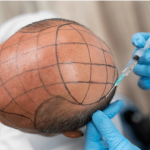Hair Transplantation for Temporal Hair Loss
Today, we will explore the world of hair transplantation, explicitly focusing on temporal hair loss. Before we start, let’s ensure we’re all on the same page. What exactly is temporal hair loss?
Temporal hair loss
Temporal hair loss, commonly referred to as hair loss on the temple region of the scalp, has a variety of reasons, such as:
- Genetics: Male-pattern baldness in men can result in hair loss above the temples, frequently forming a recognizable “M” shape. Female-pattern baldness in women typically doesn’t result in a receding hairline; instead, it might make hair less thick.
- Tight hairstyles: Man buns, cornrows, ponytails, and braids are examples of tight hairstyles that can harm hair roots and result in permanent hair loss. We call this traction alopecia.
- Other reasons: Pregnancy-related hormonal changes, stress, smoking, vitamin shortages, and drug side effects are some more factors. Hair loss in the temples may also be caused by vitamin and mineral deficits or a lack of protein.
Now that we have understood the problem, let us know about the solution: hair transplantation for temporal hair loss. A hair transplant treatment is a surgical procedure designed to restore hair to thinning or balding scalp areas. The process involves moving hair follicles from one part of the body, typically the back or sides of the scalp (where hair is more resistant to balding), to the balding or thinning areas.
Hair transplant treatment is commonly sought by individuals experiencing male or female pattern baldness. It can also restore eyebrows, beard hair, and other areas where hair is sparse or missing. The results are generally long-lasting, with the transplanted hair growing naturally in the new location. This natural growth process should reassure those considering the procedure.
The effectiveness of Direct Hair Implantation (DHITM) for temporal hair loss can vary depending on individual factors. While DHITM is a popular and advanced technique, it may not be universally considered the “best” for every case of temporal hair loss. Here’s a more nuanced perspective:
DHITM Hair Transplant for Temporal Hair Loss:
Advantages of DHI: DHITM is known for its precision, as it uses a specialized patented tool (DHI implanter) to directly implant hair follicles into the scalp without creating recipient sites beforehand. This method can offer better control over the angle, direction, and depth of hair implantation, which is crucial for achieving a natural look, especially in the temporal region.
Considerations: The temporal area can be challenging due to the need for precise placement and the natural hairline pattern. While DHITM is effective, other techniques like Follicular Unit Extraction (FUE) or Follicular Unit Transplantation (FUT) might also be suitable depending on the patient’s specific needs, the extent of hair loss, and the surgeon’s expertise.
Best Technique: There is no one-size-fits-all answer to which technique is “best.” The choice of technique should be based on a thorough consultation with a hair restoration specialist who can assess factors such as hair type, density, and the desired outcome.
Conclusion: DHITM is a highly effective technique for temporal hair loss, especially for those seeking precision and a natural look. However, the “best” technique varies from person to person and should be determined by a professional after a detailed evaluation.
Select a qualified and experienced surgeon, assiduously adhere to post-operative care guidelines, continue living a healthy lifestyle, and establish a regimen for hair maintenance.
What makes the DHITM Hair Transplant Technique the right choice for me?
With the best scientific advisory board, top-notch facilities, and US and EU patents, DHI is regarded as the industry standard for hair restoration. The ISO, CQC, TUV – Austria, ACHS – Australia, and World Health Academy have all recognized DHI.
- Completely secure: Strict protocols are implemented across all levels and processes to ensure safety.
- Result of Nature: Complete control over placement’s depth, direction, and angle guarantees a 100% natural outcome.
- No pain: Tiny disposable devices with a diameter of no more than one millimeter are used for extraction and insertion
- Assurance of Maximum Viability: While the industry average is about 50%, we guarantee above 90% graft survival rates for thick hair and natural results.
- By Doctors Only: Medical professionals who have received training and certification from the London Hair Restoration Training Academy can execute the operation from beginning to end.
- Development Throughout Life: Only healthy hair follicles—apart from telogen phase hair—are selected and implanted.
Cost of hair transplant
The cost of a hair transplant is mainly determined by the number of grafts or follicles needed to provide a patient with the most significant outcomes. Thus, giving an accurate price over the phone or online is impossible. We invite you to schedule an appointment at your nearest DHITM clinic so that you may speak with one of our experts in-depth about your hair loss condition and treatment plan. The doctor will be in a better position to estimate the precise procedure cost after your appointment.
The following will determine the cost of DHI treatment:
- The number of grafts or follicles needed to fill up bald spots
- Reason for hair loss
- Donor hair’s texture, color, and other qualities
A few hours are often all that is needed for a DHI hair transplant procedure. In some circumstances, though, further sessions may be required to achieve the desired outcomes.
Easy Financing Options for Hair Transplant Treatment at DHITM
- With various financing alternatives available, hair restoration procedures at DHI are now even more convenient and reasonably priced. Each DHITM clinic offers various and affordable financing schemes/plans.
To learn more about our simple financing options and schedule a consultation, please complete the online application on our website. You can also request a callback.
We make the following investments at DHI:
- Clinics Hygiene
- Safety Protocols (SOPs)
- Highly Trained and Certified Surgeons
- Patent Single-Use & High-Quality Instruments
7 Key questions you should ask before choosing your hair loss solution
- Who will perform the procedure?
In most clinics, procedures are performed by technicians only. The clinic owners are plastic surgeons and dermatologists, mainly involved in sales and marketing. Their involvement in the actual procedure is minimal. It would be best to go to a clinic where a doctor performs the entire procedure himself/herself, not through a technician.
It is also essential to check if the clinic or doctor specializes in hair transplants or offers other aesthetic treatments, such as Botox. A better choice would be to go for a super specialist doctor.
- Is your doctor suitably trained and certified? Do they follow standard and accredited protocols?
Doctors often learn about hair transplants from other doctors without any evaluation or certification process. It can take years for them to understand the intricacies of hair transplants. Further, most doctors do not follow written protocols and perform procedures based on personal preferences, leading to sub-optimal results.
Please check if the doctor performing the procedure has training and accreditation from a reputed institute. Very importantly, personally verify if the clinic has written protocols for all stages of the hair transplant procedure, including detailed safety protocols.
- What is the experience of the clinic/doctor you are going to?
Hair transplant is a relatively new area of practice, which has lured many doctors to leave their practice in the field of their expertise and move towards hair transplants only in the last 3-5 years. Many clinics may not have the experience, protocols, or expertise to handle hair transplant cases. Please ensure that the clinic has been established for many years and has a verifiable reputation. Do not just rely on what they claim.
- How does the clinic ensure the quality of your results?
Research shows that, on average, only half of the implanted hair may grow in specific clinics without proper experience. The clinic may not have access to the latest techniques, instruments, tools, protocols, etc. Please avoid freelancers working in many clinics on a case-by-case basis. They will likely spoil your case as they may care least for the patient. Sometimes, the doctor may be very qualified or experienced but past his prime to be able to give good results.
Do check if someone supervises the work done by the doctor. Does the doctor follow any certification, assessment, and quality monitoring process? It is not advised to go to a clinic where there is only one doctor whose work goes unsupervised.
Good results can only come with the correct technique, instruments, tools, protocols, training, assessment, and quality control.
5 How do you ensure your safety during and after the hair transplant procedure?
Generally, hair transplants are safe and cannot lead to severe risks. However, sometimes scalp infections or even more severe conditions could occur if the correct safety protocols are not followed. This risk is very high when technicians or inexperienced doctors perform a procedure.
You are advised to ask relevant questions and see the written safety protocols at the clinic.
Please see the procedure room and ask yourself if you feel confident about the safety protocols.
- Would you go for a hair transplant without a proper evaluation of your alopecia?
The answer is obviously No. There are ten kinds of alopecia. The correct treatment cannot be recommended unless a proper diagnosis is carried out. Many clinics recommend hair transplants without making a proper diagnosis. They also may not conduct a mathematical count of the donor and recipient areas to assess the hair transplant requirement and feasibility correctly. Please invest time and effort during your diagnosis and evaluate the doctor on proper dermatological examination diagnosis, precise donor and recipient area hair count, and computerized alopecia test. This results in a comprehensive lifetime treatment plan and the best results for your hair loss problem.
- Should price play a role in choosing a hair transplant clinic or doctor?
Yes, of course, price is indeed an essentialHair Transplantation for Temporal Hair Loss criterion. But it would be best if you did not choose a clinic or doctor purely on the cost. Many doctors can reduce their costs significantly by reusing the instruments, compromising on safety standards, using technicians to do the procedures, etc. Quality and Safety come at a price. This is your investment in your safety and great-looking results for life. So, choose wisely.






